About
Spider and Arachnid Life List
Updated November 2, 2025
My collection of photographs of spiders and other arachnids from my travels.
I was born with an innate fear of spiders, but slowly, I've learned to appreciate their fascinating beauty and diversity. Many species of arachnids require the help of experts to identify in the field. Unlike my other animal pages, I do not attempt to identify every spider, and certainly appreciate identification help from anybody.
Araneidae (Orb-Weaver Spiders)
Hawaiian Garden Spider
I used this photo of the large and beautiful Hawaiian Spider when writing about coral reef issues on the North Shore of Kauai. Argiope appensa, photographed on Kauai, Hawaii. Females build large vertical orbs and often add a zigzag stabilimentum. Males are much smaller and linger at the web edges.

Tropical Orb-weaver
Eriophora fuliginea, photographed in Cartago Province, Costa Rica at night on an orb web. Adults can shift color as they mature, and web architecture changes through life stages. The silk reflects light at certain angles which can draw small nocturnal insects.

Golden Silk Spider
Trichonephila clavipes, photographed in Minca, Magdalena, Colombia. This species occurs throughout the southeastern United States, Central America, South America, and the Caribbean. It was the spider I saw most during my visit to northern Colombia. The golden tint of its silk comes from UV-protective pigments and has inspired biomimetic materials research.

Golden Silk Orb-Weaver
Trichonephila clavipes, photographed on the Osa Peninsula, Costa Rica. The small spider in the upper left is the male. Extreme sexual size dimorphism is typical in this genus, with tiny males living at the web margins.

Spiny-backed Orb-weaver
Gasteracantha cancriformis, photographed on Elbow Cay, Abaco, Bahamas. I wrote about this species in my Bahamian Dry Forest journal. The armored, spined abdomen deters birds and wasps, and color morphs vary regionally across its wide range.

Spined Micrathena
Micrathena sexspinosa, photographed in Tayrona National Park, Magdalena, Colombia. Skilled builders of orb-shaped webs, these spiders wait for prey to become ensnared among dense vegetation. The six rigid spines make them difficult for predators to swallow.

Arrow-shaped Micrathena
Micrathena schreibersi, photographed in Cartago Province, Costa Rica along a fern-lined trail at night. The triangular abdomen mimics thorns or seed husks and helps it vanish in understory clutter.

Triangular Spined Orb-weaver
Micrathena pungens, photographed in the Tambopata region of Peru. This vividly marked orb-weaver is instantly recognized by its triangular abdomen with long posterior spines edged in yellow. The stiff spines likely provide armor against ants and wasps.
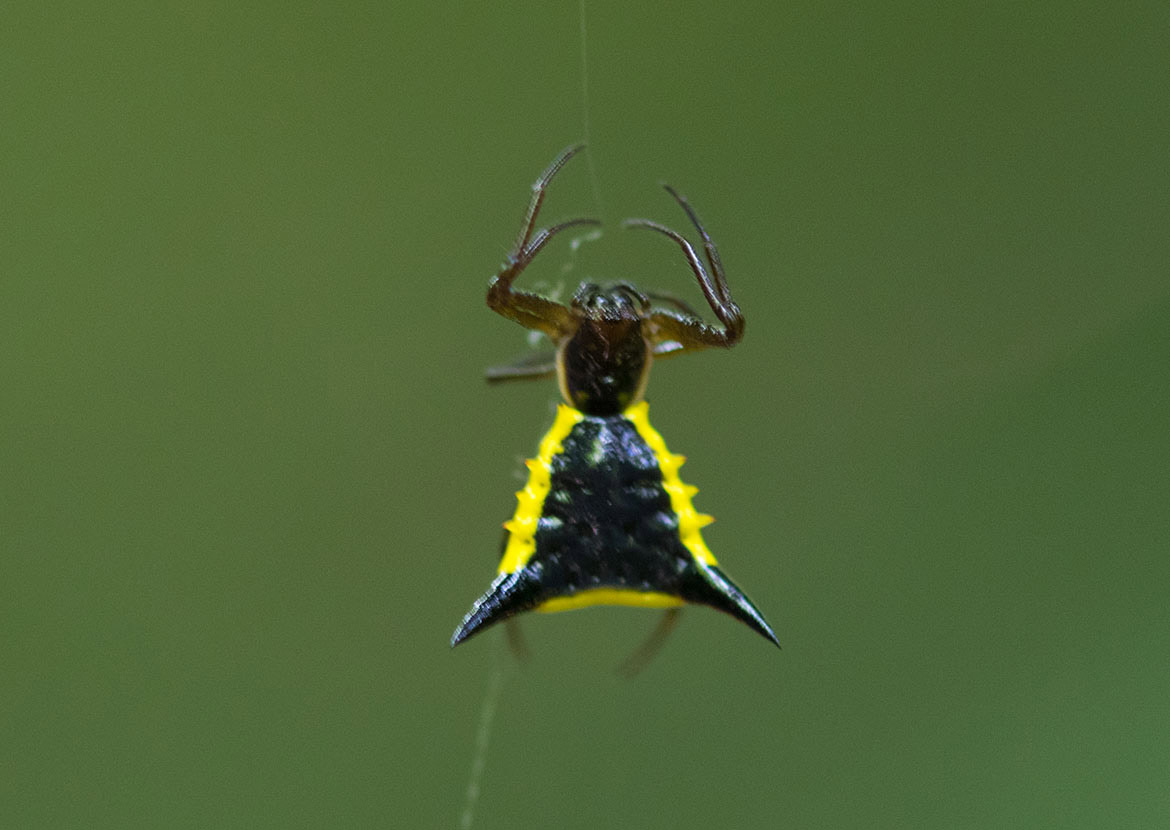
Silver Orb-weaver
Leucauge venusta, photographed in the scrublands of La Guajira, northern Colombia. This delicate spider hangs upside-down beneath its orb, its abdomen shimmering green and gold in sunlight. Many Leucauge can sense polarized light to orient webs.

Orchard Orb-weaver
Leucauge venusta, photographed in Playa Ancon, Cuba. The same species seen across much of the Americas, its silk reflects ultraviolet light that attracts flying insects. When I broke my ankle socket, tibia and fibula in a Pacific Northwest backpacking accident, it was this moment...photographing this spider, that kept going through my head that night while I awaited rescue. I was without water on a hot day in an area isolated from anybody else. My accident reminded me how careless I had been elsewhere throughout my life towards basic safety. I was lucky to be with two adept outdoorsmen in my Washington accident, but if the same accident occured in Cuba, a simple ankle accident could have meant death...a reminder for basic outdoor safety and the 10 essentials.

Cyclosa Reeves Decoy Spider
This spider, which you can see at the top of this collection of dead insects, is a tiny arachnid that designs fake spiders. This defensive strategy confused predators into attacking the fake spider. Cyclosa Reeves, I photographed this hard-to-find species while traveling to the Tambopata River region, Peru. Some Cyclosa decorate webs with prey remains or debris, forming a decoy that diverts attacks.

Ctenidae (Wandering Spiders)
Tiger Wandering Spider
Cupiennius salei, photographed in Cartago Province, Costa Rica at the entrance of its silk retreat web. This species is used in venom research; peptides are studied for neurobiology and antimicrobial potential.
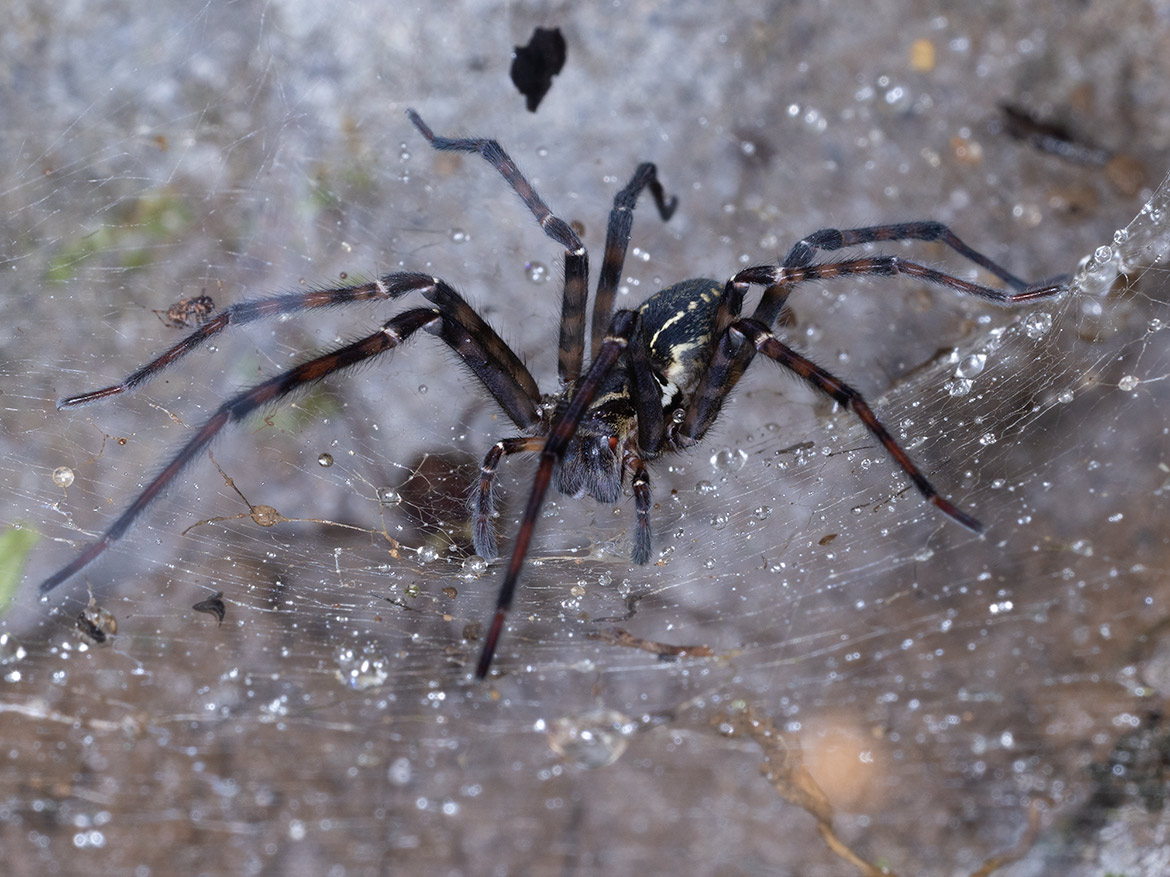
Lynx-faced Wandering Spider
Cupiennius getazi, photographed in Cartago Province, Costa Rica on a broad rainforest leaf at night. It hunts by reading leaf-borne vibrations through leg hairs rather than relying on webs.

Banana Spider
Cupiennius getazi, photographed in El Valle de Antón, Panama. Large, swift, and often mistaken for the deadly Brazilian wandering spiders, Cupiennius species are actually harmless to humans. They hide in rolled leaves by day, which likely inspired the "banana spider" name.
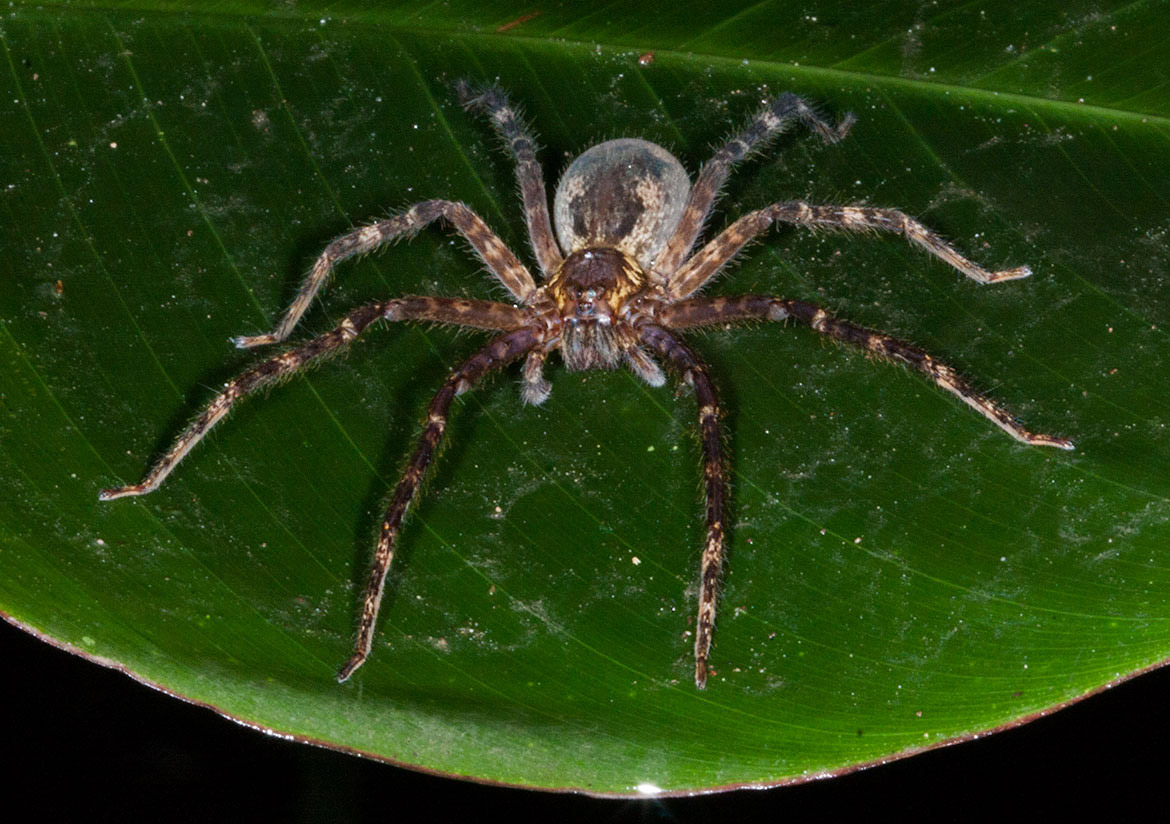
Brazilian Wandering Spider
Phoneutria fera, photographed in Tambopata, Peru, resting on a broad leaf in lowland rainforest at night. One of the most venomous spiders on Earth, but rarely aggressive and quick to retreat. The dramatic rearing threat display is meant to deter predators.


Female guarding her egg sac
In the Tambopata region of Peru, this Phoneutria cf. fera female was guarding her egg sac among low vegetation—an example of maternal behavior in wandering spiders. Females construct silken sacs and remain nearby until hatching, often turning defensive to protect their young.
Thomisidae (Crab Spiders)
Orchid Mimic Spider
Possibly Epicadus granulatus, photographed in El Valle de Anton, Panama. I write about trying to identify this species. Some Epicadus species mimic flower shapes and colors to ambush pollinators and may sit for days on a single inflorescence.

Goldenrod Crab Spider
Misumena vatia, photographed at Tualatin National Wildlife Refuge, Oregon. A flower ambusher that shifts color from white to yellow to match petals, blending with daisies and buttercups. Females can remain on the same bloom for weeks, taking bees and butterflies several times their size.

White-banded Crab Spider
Misumenoides formosipes, photographed near Summer Lake, Oregon. This pale desert crab spider hunts from lavender and sage blossoms, relying on camouflage to ambush pollinators. It can pivot its body while keeping the forelegs aimed at approaching prey.

Oxyopidae (Lynx Spiders)
Green Lynx Spider
Peucetia rubrolineata, photographed in the Tambopata region of Peru. A translucent green hunter that stalks prey among rainforest leaves, using vision and agility rather than webs. Females guard egg sacs and young on host plants.

Salticidae (Jumping Spiders)
Jemineus Jumping Spider
Lyssomanes jemineus, photographed in Cartago Province, Costa Rica on a shaded rainforest leaf. Large forward-facing eyes give acute color vision. Courtship involves subtle leg waves and body poses.
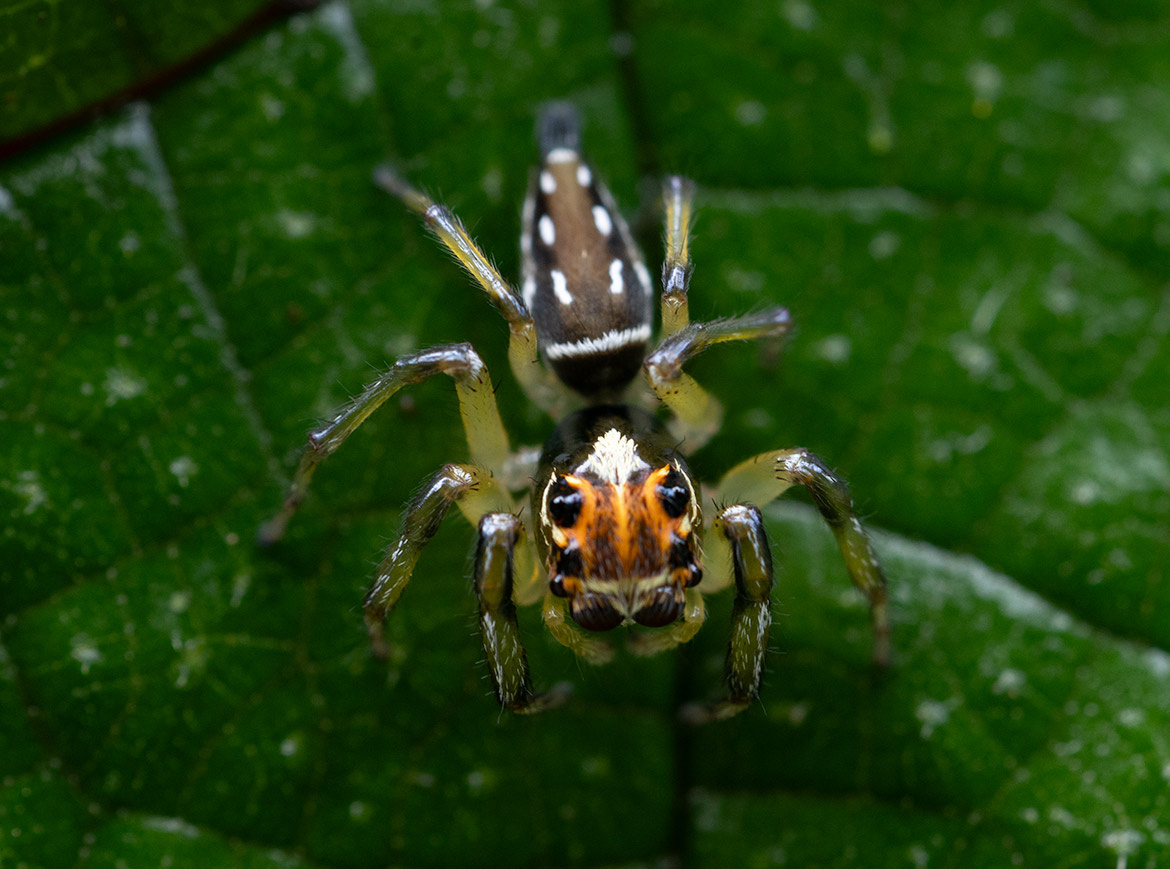
Evarcha proszynskii Jumping Spider
Photographed at Floras Lake, Oregon. This cold-tolerant species often suns on driftwood and grass stems. Like other salticids, it uses silk as a safety line when leaping.

Gray Wall Jumper
Menemerus bivittatus, photographed in Tayrona National Park, Colombia. A synanthropic species that hunts on walls and sunny surfaces. It tracks movement with head-like pivots.
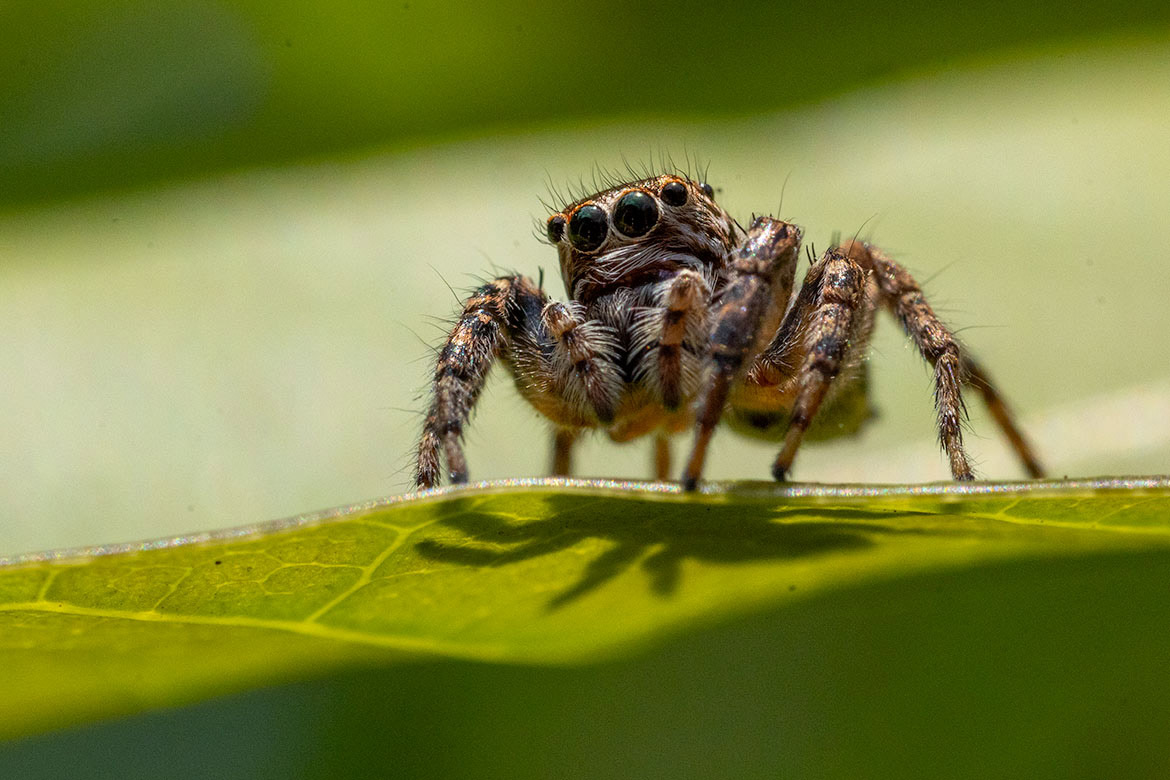
Half-edged Wall Jumping Spider
Menemerus semilimbatus, Photographed in Naoussa, Paros, Greece. Like other jumping spiders, this species, which is distributed around much of the Old World, is characterized by its excellent vision, which it uses for hunting prey. These spiders are agile hunters that actively stalk and pounce on their prey, using silk draglines for safety and as a means of communication. It is common around buildings and stone walls.

Zebra Jumper
Photographed in Tualatin National Wildlife Refuge, Oregon.

Lycosidae (Wolf Spiders)
River Bank Wolf Spider
Photographed on the Dark Divide Trail, Washington. Pardosa xerampelina. This species can run over the water surface to escape predators. Females carry egg sacs on the spinnerets.

This species walks across the surface of the water like a water bug.
Beach Wolf Spider
Arctosa littoralis, From Sunset Beach, Gearheart, Oregon. A sand specialist that digs burrows above the tideline. Eyes glow under headlamp due to a reflective tapetum.

Beach Wolf Spider
Arctosa littoralis, Photographed at Rockaway Beach, Oregon. Hunts at dusk on open sand and retreats to silk-lined burrows by day.

Theraphosidae (Tarantulas)
Costa Rican Red-leg Tarantula
Megaphobema mesomelas, photographed in Cartago Province, Costa Rica on a night walk. Noted for vivid orange leg bands and defensive stridulation. Prefers humid montane forest floor.

Kankuamo marquezi
Kankuamo marquezi, Photographed at El Dorado Reserve, Santa Marta Mountains, Magdalena, Colombia. This species, the only in its genus, was named after Colombian author Gabriel Garcia Marquez. This species is known for having urticating hairs: sword-shaped hairs that sting predators, unlike other tarantulas, which can throw their hair. Its blade-like urticating hairs can cause painful contact.

Pholcidae (Cellar Spiders)
Marbled Cellar Spider
Photographed in the Buskett Woodlands, Malta.
Holocnemus pluchei. A common synanthrope that vibrates in place when disturbed and often forms loose colonies in sheltered corners.

Amblypygi (Tailless Whip Scorpions)
White's Tailless Whip Scorpion
Phrynus whitei, photographed at Rancho Naturalista, Cartago Province, Costa Rica. Also known as White's Whip Spider, this tailless whip scorpion is an ancient and harmless arachnid of the order Amblypygi. It prowls humid canyon walls and forest floors during the rainy night, using its long whip-like forelegs to sense the world in total darkness. Its fearsome form hides a gentle nature—these amblypygids are entirely non-venomous and rely on touch and stealth rather than sting or bite.
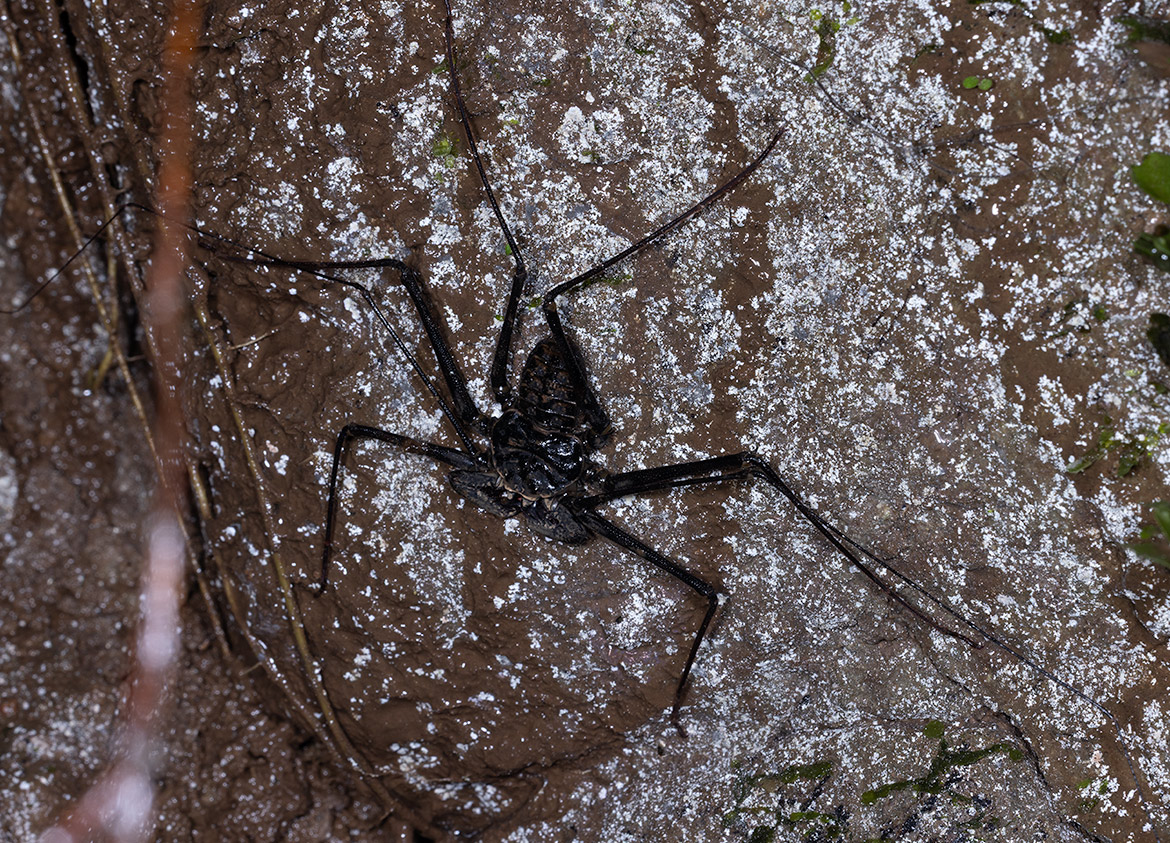
Heterophrynus elaphus Whip Scorpion
Heterophrynus elaphus, photographed in Tambopata, Peru. These arachnids are not true spiders or scorpions, but belong to the arachnid class. They are characterized by their flattened bodies, large raptorial pedipalps, and long, whip-like appendages. They are generally harmless to humans and are not venomous.

Opiliones (Harvestmen)
Phalangodus kuryi Armored Harvestman
Phalangodus kuryi, known only from the Santa Marta Mountains at high elevation. Photographed at El Dorado Reserve, Santa Marta Mountains, Colombia. Harvestmen differ from true spiders by having a fused body and a single pair of eyes; this species has a heavily armored exoskeleton adapted to life in cloud forest leaf litter.

Unidentified and Other Arachnids
Unidentified Spider
Photographed at Ridgefield National Wildlife Refuge, Washington.

Unidentified Spider
Photographed in Progreso, Yucatán, Mexico.

Unidentified Spider
Photographed in Tambopata, Peru.

Unidentified Spider
Photographed in Tambopata, Peru.

Unidentified Spider
Photographed in the Soberanía Jungle, Panama.

Unidentified Spider

